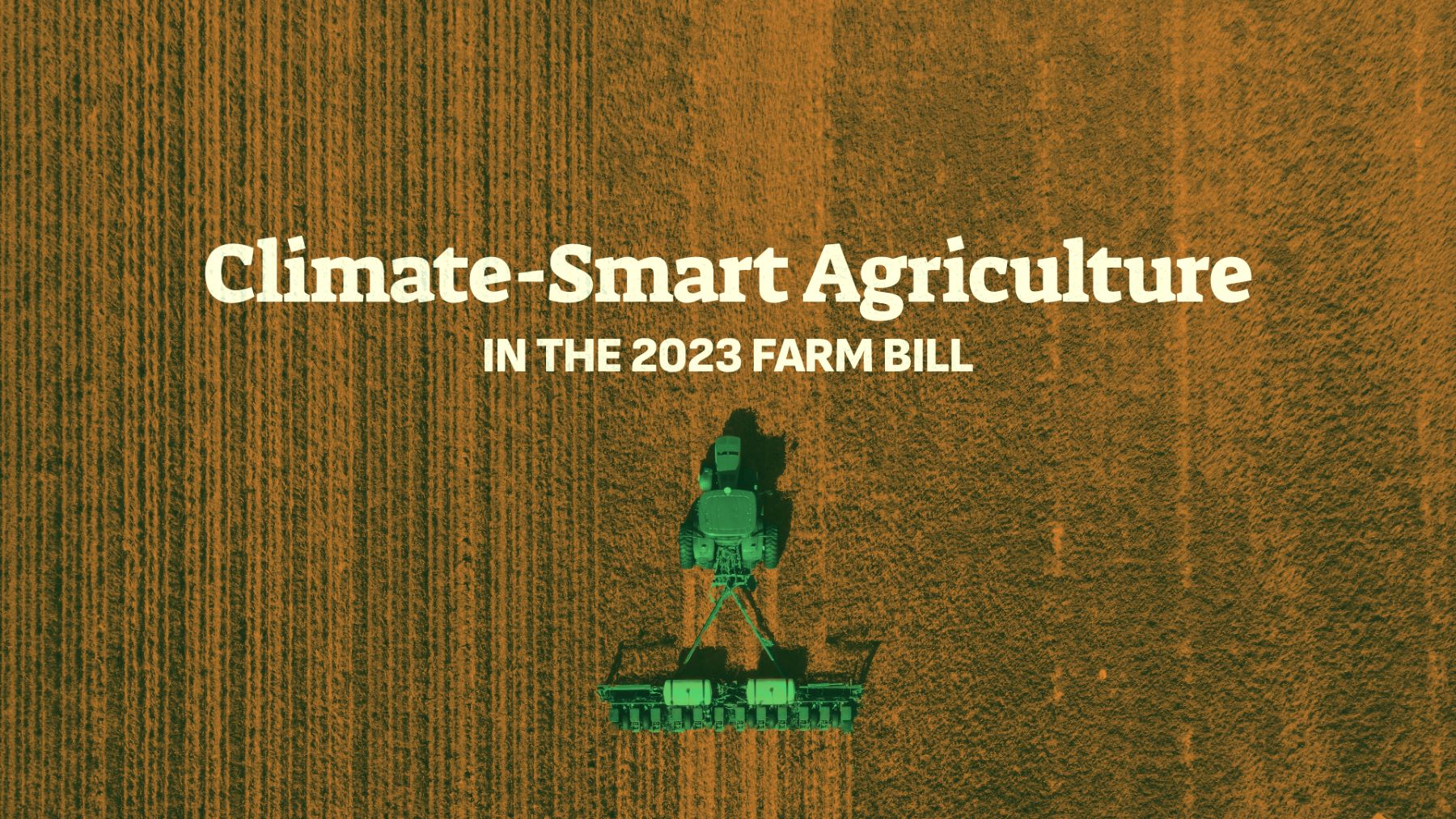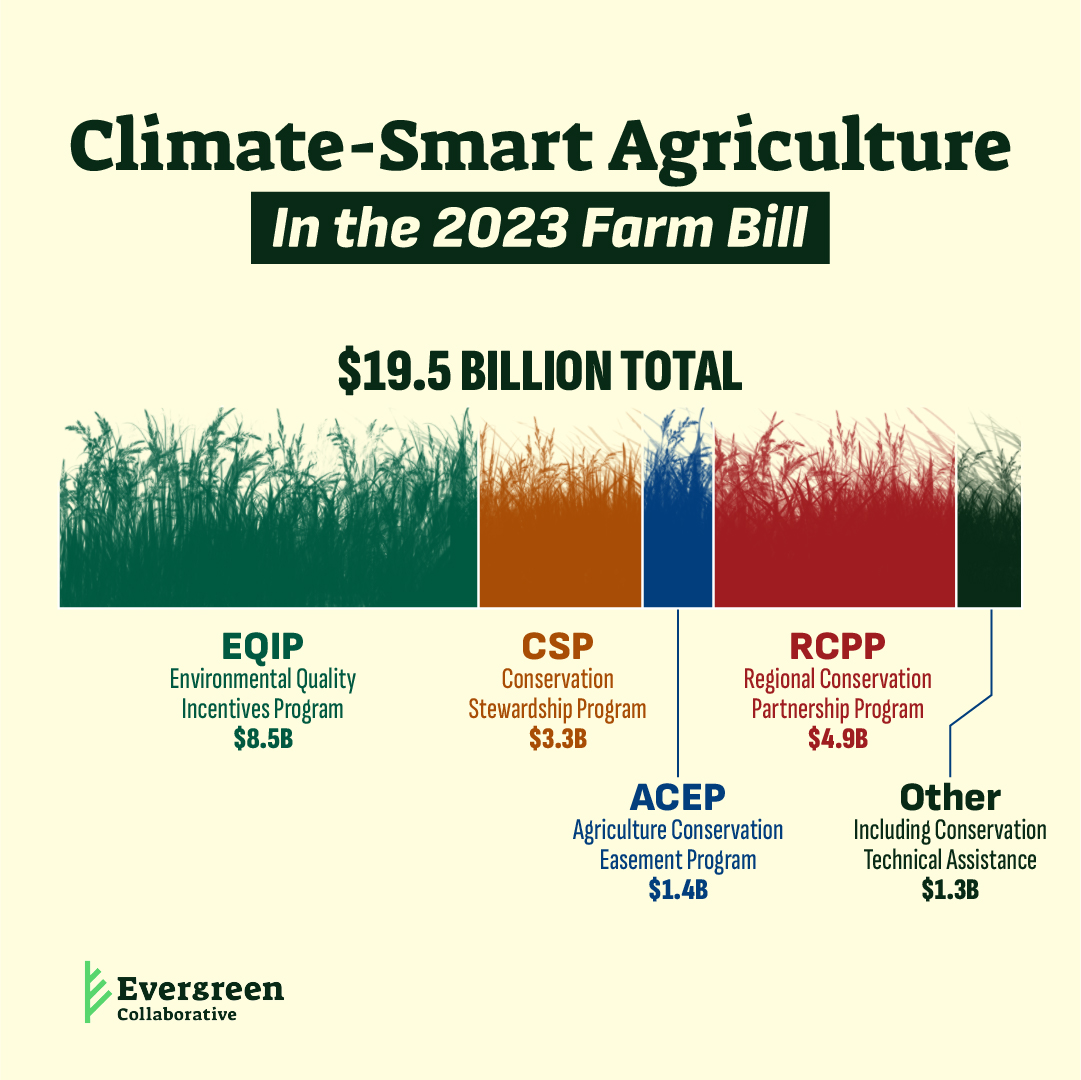Table of Contents
- Executive Summary
- The Problem: Rural America Is Facing Economic and Ecological Crises
- IRA Investments: A Historic Downpayment on a Thriving and Resilient Rural America
- What is the 2023 Farm Bill?
- How Climate-Smart Agriculture and Conservation Programs Benefit Rural Communities
- Climate-Smart Agriculture Conservation Programs in the IRA
a. Environmental Quality Incentives Program
b. Conservation Stewardship Program
c. Agriculture Conservation Easement Program
d. Regional Conservation Partnership Program
e. Other IRA funding - Conclusion
1. Executive Summary
When the Inflation Reduction Act (IRA) passed in August 2022, America’s farmers received an infusion of conservation funding. Freshly equipped with $19.5 billion for climate-smart agriculture programs, the U.S. Department of Agriculture (USDA) is more ready than ever to support working farmers, ranchers, and forest landowners with conservation programs.
And this historic funding couldn’t have come at a better time. From the crop-damaging floods in Vermont to livestock-killing heatwaves in Nebraska, this summer’s climate-fuelled disasters have hit agricultural communities hard. Fortunately, the $19.5 billion in IRA climate-smart agriculture funding is already protecting rural communities from the impacts of increasingly severe weather events, while also delivering much-needed reductions in greenhouse gas pollution.
But here’s the bad news: Republicans in Congress are threatening to revoke vital funding for climate-smart agriculture programs in the 2023 Farm Bill reauthorization. And that’s a problem for our farmers, agricultural communities, and climate. Losing climate-smart agriculture funds could destabilize small farmers and their families’ economic security, while rendering farms more vulnerable to severe weather impacts like flooding and drought.
After decades of disinvestment, rural communities deserve a thriving, clean energy economy that will deliver jobs, justice, and climate resilience, not a backslide in support. Right now, Congress has a powerful opportunity to protect the $19.5 billion for climate-smart agriculture programs for the long haul.
This memo will explain these climate-smart agriculture programs, and why they must be protected in the 2023 Farm Bill. Together, these necessary, popular, and oversubscribed climate-smart agriculture funds deliver concrete economic benefits to farmers and rural communities.
- Environmental Quality Incentives Program (EQIP) - $8.45 billion
- Conservation Stewardship Program (CSP) - $3.25 billion
- Agriculture Conservation Easement Program (ACEP) - $1.4 billion
- Regional Conservation Partnership Program (RCPP) - $4.95 billion
- Conservation Technical Assistance (CTA) - $1 billion, as well as $300 million to measure, evaluate, and quantify carbon sequestration and greenhouse gas pollution reductions from conservation investments.
2. The Problem: Rural America Is Facing Economic and Ecological Crises
Rural and agricultural communities play an essential role in America’s economy, producing nutritious food, energy resources, and raw materials for our nation. But decades of disinvestment have left America’s rural communities underserved and without adequate infrastructure. At the same time, the profits of large corporations have been consistently prioritized over the needs of family farms.
And now, this summer has clearly demonstrated that rural communities are living on the frontlines of the climate crisis. From the crop-damaging floods in California and Vermont to heatwaves sweltering Wisconsin, Colorado, and Iowa, climate-fuelled disasters are already hurting agricultural communities.
Let’s be clear: This is a matter of economic importance to rural America. Many of America’s farms, especially small-scale family farms, operate on razor-thin profit margins, and increasingly severe climate impacts are disrupting their operations and hitting their pocketbooks hard.
This is also about protecting America’s food security and trade exports. Climate change is slated to negatively impact corn and wheat productivity by 2030. U.S. farms supply nearly a quarter of all grains on the global market, and climate-fuelled crop productivity decline raises domestic and international food security concerns and prices. What’s more, the increased frequency of heavy precipitation across the nation is expected to erode soil, deplete nutrients, and harm crop productivity. And climate-fueled heat waves are already threatening livestock health.
At the same time, status-quo agricultural practices are degrading our land and climate. The agricultural sector currently comprises over 10 percent of total U.S. greenhouse gas pollution. These harmful emissions stem from diverse sources. For example, over-using fertilizers on crops releases nitrous oxide, a planet-warming greenhouse gas that is 300 times more powerful than carbon dioxide. Livestock like cattle, sheep, and goats produce methane pollution as they digest their food, while manure deposits result in nitrous oxide and methane pollution. Together, these potent greenhouse gasses trap heat in the atmosphere and contribute to climate change.
In the midst of these overlapping economic and ecological crises, rural and agricultural communities deserve a thriving clean energy economy that will deliver jobs, justice, and climate resilience. As we wrote in the Evergreen Action Plan, the federal government must ensure there is a long-term reinvestment plan for rural and agricultural regions that secures a prosperous and resilient climate future. Such a reinvestment plan would allow working communities to preserve agricultural livelihoods, while growing innovative climate solutions and job opportunities.
3. IRA Investments: A Historic Downpayment on a Thriving and Climate Resilient Rural America
Here’s the good news: When Congress passed the IRA last August, they anticipated the need for a thriving clean energy economy in rural America. Congress understood that climate-smart agriculture practices could support farmers in mitigating climate change impacts. That’s why the historic act included $19.5 billion in additional funding for existing climate-smart agriculture programs, the largest investment in agricultural conservation funding since the Dust Bowl. They also invested $10.7 billion in rural clean energy generation and transmission, which will help supply cheaper and more reliable energy to rural industries, while creating an estimated 90,000 jobs.
And already, these once-in-a-generation investments are proving wildly successful. Some of the nation’s poorest rural communities are attracting lucrative clean energy projects that will bring jobs and tax revenue. Meanwhile, the U.S. Department of Agriculture’s (USDA) climate-smart agriculture programs remain popular and consistently oversubscribed by farmers, landowners, and ranchers.
4. What is the 2023 Farm Bill?
The farm bill is an omnibus, multi-year law that addresses agricultural and food programs and policy. The first Farm Bill dates back to the 1930s when America was at the height of the Great Depression and the Dust Bowl was ripping across the Great Plains. When the Agricultural Adjustment Act passed in 1933 as part of the New Deal, the intent of the legislation was to keep food prices fair for farmers and consumers, while preserving natural resources to stop future environmental disasters like the Dust Bowl.
Today, the Farm Bill is a package of legislation that Congress typically renews every five years. This legislation governs policies related to the agricultural sector, including farm income support and food assistance. The most recent farm bill was enacted in December 2018 and expired on September 30, 2023. (It’s worth noting that it does not need an official stopgap funding measure until January 1, 2024.)
Just as farmers of the 1930s required federal intervention to avert another environmental disaster like the Dust Bowl, modern farmers need federal support to help them conserve their lands and adapt to the cascading impacts of the climate crisis. But as negotiations for the 2023 Farm Bill heat up, Republicans in Congress want to cut billions in funding for climate-smart agriculture and rural electrification through the 2023 Farm Bill. Fortunately, Senator Debbie Stabenow (D-MI, Chairwoman of the Senate Committee on Agriculture, Nutrition, and Forestry) is actively working to prevent any efforts to remove the $19.5 billion in climate-related agriculture from the 2023 Farm Bill. Now, it’s up to Congress—and specifically, House Democrats—to protect this additional IRA climate-smart agriculture funding in the 2023 Farm Bill.
5. How Climate-Smart Agriculture and Conservation Programs Benefit Rural America
The USDA’s additional $19.5 billion in climate-smart agriculture funding is already helping farmers cut down on greenhouse gas pollution at the source while also enabling farmers to make their existing operations more climate-resilient. Here’s why these programs are such a good deal for rural and agricultural communities:
USDA’s climate programs are popular and already oversubscribed.
Application statistics show that USDA’s existing conservation programs are popular, beneficial, and oversubscribed. Take, for example, the Conservation Stewardship Program (CSP) and Environmental Quality Incentives Program (EQIP). Each program is regularly inundated with applications from farmers and producers. Last year alone, CSP and EQIP rejected more than 110,000 farmers. According to a USDA presentation in August 2023 and a recent press release, even with additional IRA funds, the Natural Resources Conservation Service (NRCS) still receives more requests for EQIP, CSP, ACEP, and RCPP than there is available funding. That means farmers have been turned away from these vital programs due to insufficient funding, demonstrating that demand exceeds supply—and that this additional $19.5 billion is sorely needed.
What’s more, support for these programs remains strong, with 644 organizations, businesses, and farmers sending a letter to Congress to protect the $19.5 billion in climate-smart agriculture conservation programs through the 2023 Farm Bill.
Revoking needed funding for USDA’s climate-smart agriculture and conservation programs would be a mistake for working farmers, their communities, and our environment—especially when these programs are consistently in high demand and benefit all farmers and ranchers. (It’s worth noting that conservation funds benefit all farmers and ranchers—while reference price increases would only benefit the wealthiest farmers.)
USDA’s climate programs make rural communities more climate resilient – while delivering economic benefits to farming communities.
Make no mistake: These conservation programs aren’t simply oversubscribed programs with short-term benefits. The $19.5 billion in additional funding also provides long-term investments that will safeguard soil health, water quality, biodiversity, and climate resilience.
Notably, Congress attached parameters to this climate-smart agriculture funding. They stipulated that the funding must be specifically used for climate change mitigation, or activities that reduce, capture, avoid, or sequester harmful greenhouse gas pollution. Such climate-smart agriculture practices are well-known among farmers and ranchers. They include planting cover crops, wetland restoration, reduced-till and no-till, nutrient management, prescribed grazing, tree planting, and more – with each offering immediate on-farm benefits.
Climate-smart agricultural practices help farmers tackle environmental and water pollution, while also cutting methane and nitrous oxide pollution. For example, planting medium- or long-term cover crops helps sequester carbon dioxide into soils, while also trapping excess nitrogen. Similarly, planting native trees or shrubs sequesters and stores carbon, while helping prevent erosion. And cracking down on excess fertilizer through nutrient management reduces planet-warming nitrous oxide pollution and water contamination. At the same time, climate-smart agriculture practices can increase climate resilience during extreme weather events. For example, cover crops and no-till practices increase soil health and water-holding capacity, making crops more resilient to intensifying droughts or floods.
Better still, climate-smart agriculture practices put money in farmers’ pockets. For example, lowering inputs of fertilizer doesn’t just mean less pollution—it also translates to cost savings for farmers. These savings are significant when fertilizer accounts for nearly one-fifth of farmers’ cash costs.
The economic benefits of these programs are also far-reaching. The White House estimates that this IRA funding supports up to 280,000 farmers and ranchers with conservation efforts across approximately 125 million acres of land.
We can’t afford to disinvest in farm operations, farmworkers, and rural communities that supply America’s food during a mounting climate crisis. Our food systems should be protected from the climate crisis, and shouldn’t unnecessarily contribute to it—climate-smart agriculture programs will help with just that.
6. Climate-Smart Agriculture Conservation Programs in the IRA
Now, let’s take a closer look at the five climate-smart agriculture programs in the IRA.

